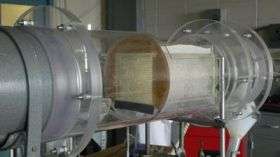Cutting carbon: New tech traps, stores airborne emissions

In a finding that could shrink the massive carbon footprint of cars worldwide, a New York scientist has proposed an industrial technology that captures CO2 directly from the atmosphere. The study is scheduled to appear in the Nov. 1 issue of ACS' Environmental Science & Technology.
Current Carbon Capture and Storage (CCS) technologies focus on large, stationary sources like power plants. But even if the capture sites were at full deployment and efficiency, "more than 50 percent of global emissions would remain unabated," writes the author.
The remaining emissions, often from dispersed and mobile sources, require other mitigation techniques. According to the author, "atmospheric CO2 emissions may double this century." These CO2 forecasts lend urgency to the search for a more comprehensive carbon capture system.
Frank Zeman addresses the ambient emissions with a new 'Air Capture' system that absorbs CO2 straight from the atmosphere. While it provides a very different approach to carbon capture, the CO2 storage technologies would be the same used in conventional CCS. The leading challenge of air capture technology arises from the low concentration of ambient CO2 -- 4,697 cubic feet of ambient air must be processed to capture about 2 ounces of carbon dioxide!
Zeman proposes a number of solutions, including a design that uses natural drafts to absorb vast amounts of air at little to no energy cost. The comprehensive devices could be installed anywhere, writes the author, and would trap and store carbon as efficiently as current capture technologies.
Source: ACS





















